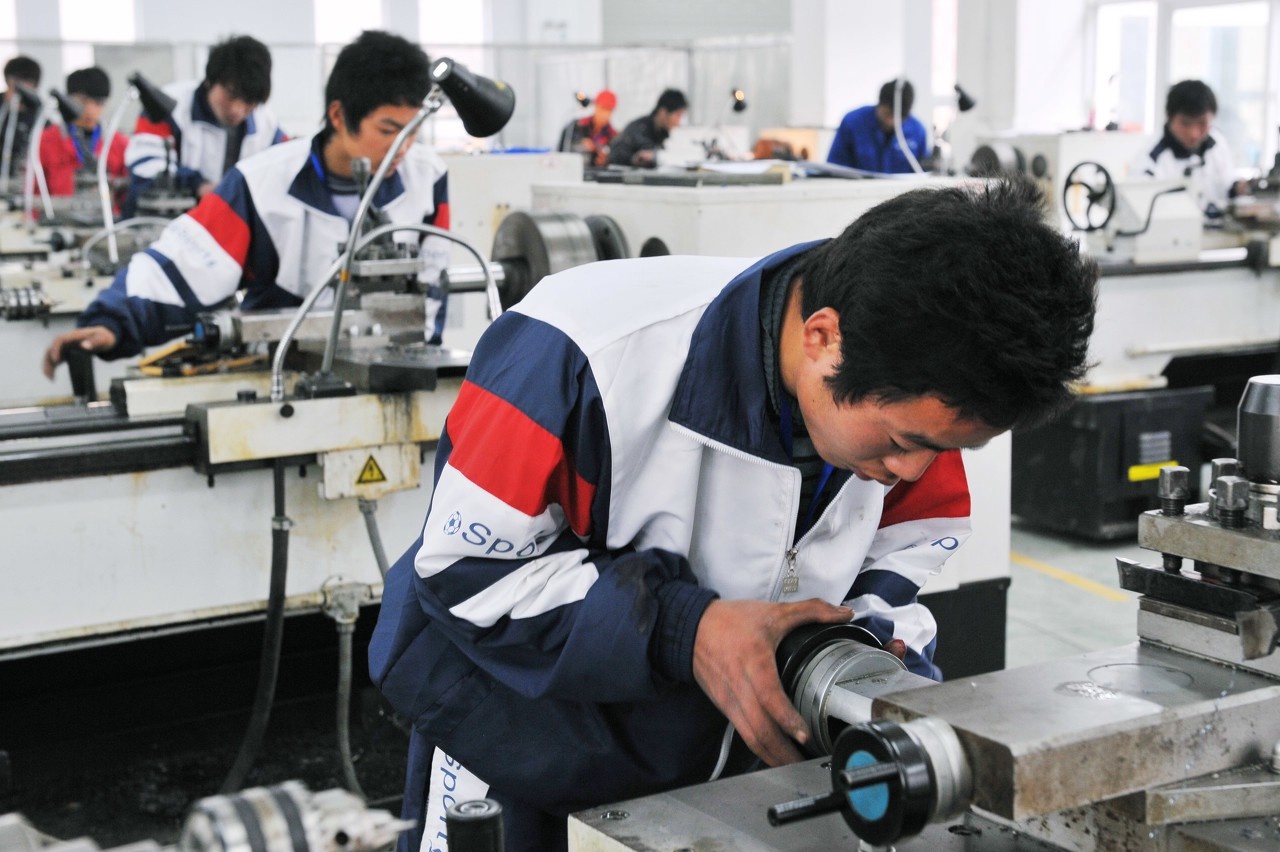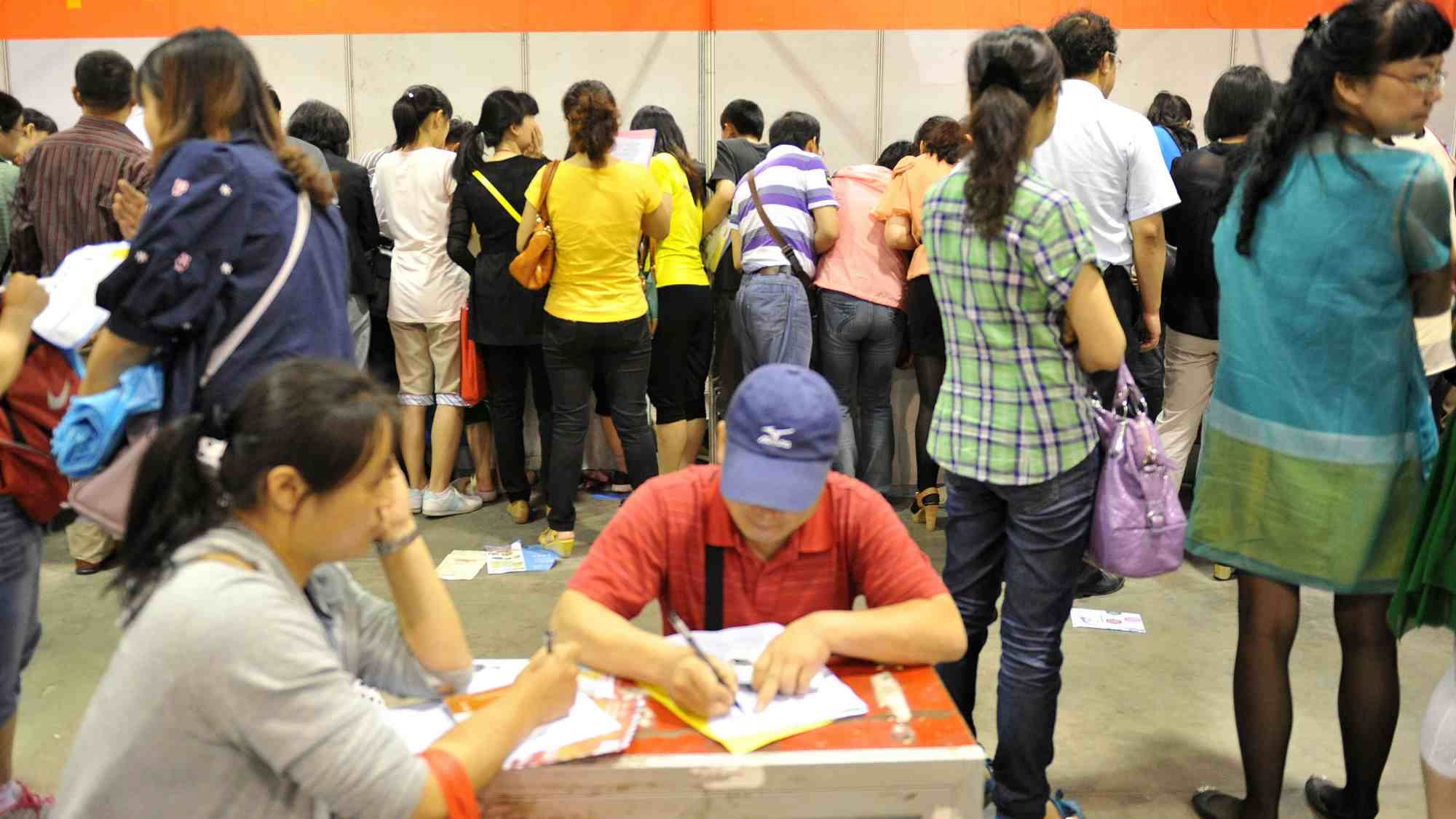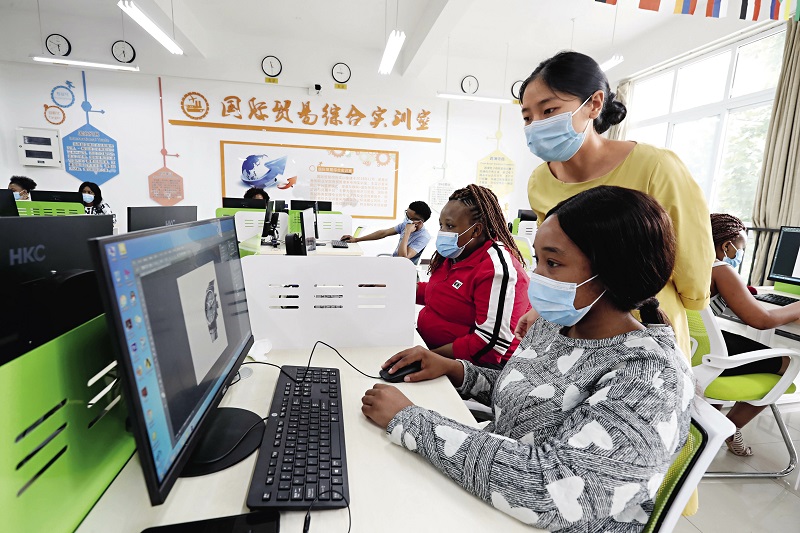Understanding China’s Vocational Education Reform and Its Implication to the World
November 01, 2021
About the author:
Dr. Liu Jinghui, Senior Fellow of Taihe Institute, Secretary-General of China Scholarship Council (2008-2017)
KANG: Would you please briefly tell us about the plan for the ongoing vocational education reform?
LIU: In fact, education in China has been in the process of reform, development, and innovation since the beginning of China’s reform and opening up 42 years ago.
Vocational education is an important part of educational reform and development. Over the past five years, the Chinese government has issued a series of policies and measures on reforming and developing vocational education. Relevant data shows that China has made great progress in developing vocational education. Currently, China has 11,500 vocational schools, with a total of 28.5718 million enrolled students. There are 6.0037 million students attending secondary vocational schools, accounting for nearly half (41.7%) of all students receiving high school education. About 4.8361 million students are enrolled in higher vocational colleges (short-cycle higher education), accounting for 52.90% of all students receiving general vocational-technical education.
Of the vocational education reform policies in recent years, the most influential one is the Notice on Issuing the National Vocational Education Reform Implementation Plan by the State Council in January 2019. I think I should highlight several messages conveyed in the Notice.
The first one is about the positioning of vocational education. That is, vocational education is regarded as another type of education for talent training. This was the first time that China established the status of vocational education in an official document. It was a watershed event that might help change the public’s perception concerning vocational education, and it also marked a major breakthrough in the future development of China’s education sector.
The second one is about the idea of building a modern vocational education system characterized by vertical and horizontal integration and breaking the ceiling of professional training programs. Horizontal integration refers to the seamless connection of vocational education with general education and continuing education. In the past, when people talked about vocational education, they would think that their learning would reach the top as they finish their professional training programs, which tend to be short-term. Indeed, they could use vocational education as a springboard and transfer to universities through continuing education. But starting from 2019, within the framework of horizontal integration, China began to introduce vocational education programs at the undergraduate level in some pilot cities. Now, the degree that students would receive from these programs is supposed to be treated equally as a bachelor’s degree.
The third one is about the revision or formulation of major lists and curriculum standards.
Another one is about the introduction of the “1+X certificate” system, which was a move taken by the CPC Central Committee and the State Council to enhance the strength of vocational education and promote education-industry interaction via school-enterprise cooperation. In other words, the move was to further reform talent training models and enhance the adaptability of vocational education by incorporating industry and enterprise standards into the curriculum. The “X” serves as a supplement to and an expansion of the “1”—the academic credential.
Over these years, China has been advocating the integration of education and industry and the cooperation between schools and enterprises in vocational education. In fact, this was inspired by the German dual system of vocational education, as it is a type of education that nurtures talents geared towards market needs and direct participation in socio-economic development. Therefore, it is necessary for students to understand enterprise operations and industry development during their studies. In other words, students attending vocational school should not only have a firm grasp on professional knowledge and skills, but, more importantly, they should have the opportunity to practice what they have learned in enterprises during their studies so that they can be well adapted to their work after graduation. The “1+X certificate” model was designed to enhance career adaptability. Now, China has already approved the introduction of 447 certificates in different industries. But I think this is far from enough.

(Source: edtechchina.medium.com)
KANG: Could you be a little bit more specific about the connection between China’s vocational education and Germany’s dual-system vocational education?
LIU: China began to draw on foreign experiences, including Germany’s dual-system vocational education we just talked about at an early stage of reform and opening up. Since the early 1980s, there have been dual-system vocational education pilot programs running in various schools and cities, such as Suzhou, Wuxi, Changzhou, and Wuhu. As part of the comprehensive educational reform, vocational education was not isolated and could not develop in isolation.
The so-called dual system is an educational approach, in which the government and enterprises cooperate to train technical workers in the process of vocational education. The remarkable achievements of the German manufacturing industry, especially the country’s economic take-off after World War II, should be attributed to its unique dual-system vocational education and the high skill levels of its technical workers. German entrepreneurs believe that first-class products are the results of R&D by innovative researchers as well as the high proficiency levels of skilled technical workers. Without proficiency in technical skills, advanced scientific research achievements can hardly be transformed into competitive products.
The gist of the so-called dual-system vocational education, as the name suggests, lies in the term “dual.” The term can be approached from the following perspectives:
The first one refers to dual training institutions, namely enterprises and vocational schools. In Germany, more than 500,000 (about 20%) of the total of over 2.6 million enterprises have participated in dual-system vocational education.
Second, the dual-system can be understood as a dual-track type of education, covering vocational skills and professional theories. Students (apprentices) engage in skill and theory training in enterprises for three to four days a week and study academic and specialized courses in vocational schools for the remaining weekdays.
Third, dual textbooks for practical and theoretical training, respectively. Host enterprises use practical training textbooks compiled by the Federal Institute of Vocational Education and Training to ensure uniform standards and consistent quality of vocational skill training.
The forth one refers to dual teachers for practical and theoretical training, respectively. Employees of a host enterprise may serve as full-time or part-time teachers for practical training.
Fifth, dual identities—apprentices at enterprises and students at vocational schools. As apprentices, students need to sign a legally binding training contract with the host enterprise, which clearly stipulates the rights and obligations of both parties during the training process. Most students who complete their apprenticeships at the corresponding enterprise will become eligible employees (upon their own will) of the enterprise before their graduation.
The term also concerns dual exams—skill exams and qualification exams, and dual certificates—vocational qualification certificates issued by the relevant guild and graduation certificates issued by the school.
In Germany, technical workers trained this way normally enjoy high social status and make good money. After graduation, these technical workers can still pursue continuing education at work. With a grasp of professional skills, they can support their family and lead a stable well-off life. Due to the high demand of the manufacturing industry for technical workers in recent years, 65% of middle school graduates would choose dual-system vocational education over the usual high school-university path. Of course, the door of colleges and universities remains open to them after they finish their vocational education if they are willing and academically qualified to pursue further education.
(Source: www.tr-academy.com)
KANG: New Zealand and some other countries also have their unique vocational education models. Why did China choose to learn from Germany’s dual system instead of anything else of other countries?
LIU: Since the reform and opening up, China and Germany have maintained close cooperative ties in the field of education, and this have led to fruitful results. We can, and we have learned a lot from the design of the dual-system vocational education model. But China’s interaction with the outside world is not confined to its exchange with Germany. We have also been learning from the successful practices of some other countries, such as the micro-credentials system of New Zealand, the competency-based education (CBE) curriculum development of the United States, and the vocational qualification systems of the UK and Australia. We have carried out pilot programs at the national, provincial, or school level in many schools and across many disciplines. Overall, these programs represent continuous progress in China’s reform and opening up in the field of education. They are not only about technical learning but also about educational methods. For example, many schools are experimenting with the project-based teaching method and the competency-based curriculum development model.
KANG: How do we adjust vocational education to the current social context, and what do you think of people’s stereotypical image about vocational education?
LIU: How we can enhance the adaptability of vocational education is more of a question about how we reform vocational education prospectively than one about what we have run into the ground.
First, fundamentally and essentially, vocational education must meet the needs of first, socio-economic development and second, people’s all-around development. In other words, the adaptability of vocational education to the socio-ecnomoic change as well as the mutual adaptability between vocational education and people’s comprehensive development should come into play to serve both needs. This has been a topic of interest for many years for educational theorists and practitioners. Since 2019, the Chinese government has issued many documents, policies, and measures in this regard, such as “cultivating talented people with high moral standards,” “integration of industry and education,” “the reform concerning teachers, teaching materials, and teaching methods.” However, striking a balance between the two so that vocational education serves to teach students practical skills and to thrive as a person is a long process that requires a lot of efforts.
Second, regarding the reform of vocational education, we should shift from “reactive adaptation” to “proactive adaptation.” Discussion on vocational education should not be limited narrowly to people in the educational field, especially in the vocational education circle. In the future, students of secondary vocational schools, higher vocational colleges, or undergraduate-level vocational colleges are expected to not only react by participating in the production process and completing specific production tasks after they graduate but, more importantly, to be able to actively participate in planning the development of their employers (departments) during their studies and take ownership of their work. To make this happen, relevant people from the economic and business circles should be invited to participate in the whole process of designing adaptive vocational education systems.
Third, China is advancing toward its second centenary goal of fully building a modern socialist country that is prosperous, strong, democratic, culturally advanced, and harmonious. Accordingly, China is undergoing a new round of industrial restructuring fueled by the fourth industrial revolution. For example, China has proposed the rural revitalization strategy to develop its central and western regions. On the adaptability of vocational education, I want to talk about the concept of “reverse adaptation” to approach it from a different angle. To be more specific, the country should also consider adjusting its economic and industrial development plans in a way to serve the development of vocational education and the demand for vocational skills. Some industrial and R&D departments can take the initiative to set up entities in small- and medium-sized cities or villages in central and western China to better facilitate rural revitalization and retain local talented people.
Indeed, people tend to discriminate against vocational education, thinking that students settle for vocational education because their “poor academic performance” or “low college entrance test scores” force them to “seek a way out.” As mentioned above, in recent years, the Chinese government has issued a series of policies to enhance the adaptability of vocational education, thus improving the attractiveness and status of vocational education. For example, the undergraduate-level vocational education model provides a path to higher education for vocational learners. Theoretically, it is designed to dispel the whole idea of creating hierarchies in education. In addition, to achieve equality in educational opportunities, the Chinese government has taken measures to reduce tuition fees and provide living allowances for students in and from poor areas.
(Source: news.cgtn.com)
KANG: It seems like international exchanges and mutual learning are important for us not only in the oft-cited economic sector but also in the education sector. So what are the goals for China’s education reform? More specifically, would you please give us some ideas on the objectives of the deepening of China’s vocational education reform?
LIU: The year 2021 is the first year of implementing China’s 14th Five-Year Plan when we can evaluate our educational reform and development efforts during the 13th Five-Year Plan. Based on the preceding achievements, the 14th Five-Year Plan lists nine major tasks for vocational education development. Here I would like to share my interpretation of these major tasks.
First, fully implement the fundamental task of cultivating talented people with high moral standards. This task is about what kind of people to cultivate.
Second, improve modern vocational education systems, consolidate the status of secondary vocational education, and adhere to the policy of equal development of general education and vocational education in the high school stage. As I said, the ratio of students enrolled in vocational education to those enrolled in general education was about 41.7% in 2019. We should maintain this ratio in the high school stage. In addition, we should enhance the status of short-cycle higher education and vigorously promote vocational education at the undergraduate level.
Third, deepen the integration of industry and education and the cooperation between schools and enterprises, and build industry-education integration groups (alliances) and training bases.
Fourth, comprehensively improve the quality of talent cultivation. This involves reforms of curricula, teaching materials, and educational evaluation systems.
Fifth, encourage teachers to develop both practical and theoretical teaching abilities.
Sixth, promote open cooperation in vocational education. This task puts special emphasis on encouraging the introduction of internationally recognized certification, supporting qualified schools in helping enterprises go global, setting up Silk Road School in Belt and Road countries, pushing forward with vocational education pilot programs in China co-led by enterprises and colleges, and striving to form a Chinese-specific dual-system talent training model that can be popularized and replicated.
Seventh, improve the social service capabilities of vocational schools. This task goes along the same line as improving the adaptability of vocational education, as I mentioned earlier.
Eighth, boost digital adoption in vocational education, that is, apply AI and other technological advances in vocational education. For example, build smart campuses that use advanced network infrastructure and Internet-connected services, and create 50 high-quality vocational schools, 50 competitive and characteristic majors, and high-quality courses taught by 100 top teachers on the cloud.
Ninth, deepen the comprehensive reform of vocational education. Overall, the current round of vocational education reform is to improve the quality and efficiency of vocational education and further strengthen international exchanges and cooperation in this regard.
(Source: www.pressreader.com)
After four decades of reform and opening up, we should continue going global and bringing in premium resources. We should also draw more lessons from the vocational education practices in western developed countries and innovate based on these lessons. I know that 20 or 30 vocational schools in China have fully introduced Germany’s qualification certification system. Students are trained according to the German model and will take skill certification exams in line with German standards. The guild-issued certificates are of high value as the exams are supervised by certified teachers. A good example is that more than 30 graduates from Dongguan Technician College have obtained German certificates and signed labor contracts with German enterprises.
To promote “going global”, China calls for the building of vocational education cooperation centers in Belt and Road countries. Specifically, China supports qualified schools in helping enterprises go global by jointly setting up Silk Road Schools, Luban Workshops, and other educational institutions in Belt and Road countries to cultivate local talents for these enterprises. In this way, we can better promote cultural exchanges between China and foreign countries.
Thus far, we have achieved remarkable results in high-level visits and inter-university exchanges. However, cultural exchanges are not limited to these but incorporate interactions at various levels. I think there is still a great potential for cooperation in vocational education and that exchanges at this level can promote mutual communication and understanding between the Chinese and foreign young people and allow the rest of the world to understand the logic behind China’s development.
KANG: What are the messages of the vocational education reform for the outside world? What opportunities or challenges will it bring to the outside world, including foreign enterprises?
LIU: Over the past few years, some Chinese enterprises and higher vocational colleges have started cooperation with Belt and Road countries. We translated the courses of China’s short-cycle higher education into local languages. Local students attended classes taught in accordance with our educational syllabus and took exams based on our exam guidelines. As a whole, China’s vocational education courses and exams were in general highly recognized in foreign countries. But so far, we have not formulated a set of internationally accepted qualification standards.
Therefore, in this reform, China calls for active participation in the formulation of international standards related to vocational education. Many countries and regions have taken vocational education as an important part of lifelong education and have established their own governance framework. The framework can vary based on each country’s specific cultural and social conditions. For example, despite being an active advocate of the EU self-regulation framework, Germany has its own national governance framework that is different from the EU framework. Compared with the EU, Germany has higher and more specific requirements for talent training.
Therefore, China should assimilate and improve what it has learned from the West and strive to form a China-specific dual-system talent training model that can be popularized. The talent training model with Chinese characteristics aims to cultivate talented people with high moral standards and promote the moral, intellectual, physical, and artistic development of students. Like general education, vocational education for the training of skills and techniques is also responsible for improving people’s essential qualities and cultivating talent.
This is by no means a small goal. It sends an important message to the outside world that China is seeking broader and deeper international cooperation. For foreign countries, this means opportunities. China should build a platform for high-level vocational education cooperation and exchanges and steadily promote school-enterprise initiatives to run vocational education schools in China to provide useful examples for such cooperation.
China has launched several vocational skill competitions in partnership with countries such as Australia and Belgium. Meanwhile, China encourages vocational schools to enroll excellent international students from all over the world, especially from Belt and Road countries. In the future, we hope that, by means of education and through mutual learning, we can broaden the platform for exchanges between China and the rest of the world and improve China’s capability to cooperate with other countries.
TI Observer (TIO) is a monthly publication devoted to bringing China and the rest of the world closer together by facilitating mutual understanding and promoting exchanges of views. If you are interested in knowing more about the October issue, please click here:
—————————————————————
ON TIMES WE FOCUS.
Should you have any questions, please contact us at public@taiheglobal.org



